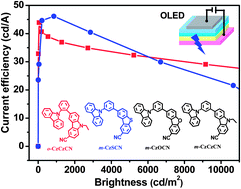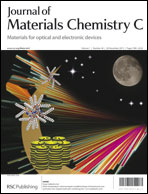Simple bipolar host materials incorporating CN group for highly efficient blue electrophosphorescence with slow efficiency roll-off†
Abstract
A group of small-molecular compounds, namely 6-(3-(9H-carbazol-9-yl)phenyl)-9-ethyl-9H-carbazole-3-carbonitrile (m-CzCzCN), 6-(2-(9H-carbazol-9-yl)phenyl)-9-ethyl-9H-carbazole-3-carbonitrile (o-CzCzCN), 6-(3,5-di(9H-carbazol-9-yl)phenyl)-9-ethyl-9H-carbazole-3-carbonitrile (mCPCzCN), 8-(3-(9H-carbazol-9-yl)phenyl)dibenzo[b,d]furan-2-carbonitrile (m-CzOCN), 8-(3-(9H-carbazol-9-yl)phenyl)dibenzo[b,d]thiophene-2-carbonitrile (m-CzSCN), are designed and synthesized for use as host materials in blue phosphorescent organic light-emitting diodes (PhOLEDs). The p-type carbazole and the n-type cyano-decorated carbazole, dibenzofuran or dibenzothiophene unit are incorporated, to either the meta- or ortho-positions of the phenylene bridge. The bipolar feature was confirmed by theoretical calculation and experimental results of the single-carrier devices. These materials exhibit an excellent performance in their hosted blue phosphorescent OLEDs with iridium(III)bis(4,6-(difluorophenyl)pyridinato-N,C2′)picolinate (Firpic) as the doped emitter. The ortho-substituted o-CzCzCN realizes higher device efficiencies than the meta-substituted isomer m-CzCzCN, with a maximum external quantum efficiency of 21.0% and a current efficiency of 43.9 cd A−1. The device hosted by m-CzSCN also exhibits remarkably high efficiencies of 23.3% and 46.1 cd A−1. Furthermore, these blue PhOLEDs are characterized by a slow efficiency roll-off. Even at a high brightness of 10 000 cd m−2, the o-CzCzCN hosted device still retain high efficiencies of 13.6% and 28.5 cd A−1. This is a systematic study of incorporating the CN group onto carbazole, dibenzofuran and dibenzothiophene, to develop high-triplet-energy bipolar hosts for OLED applications.


 Please wait while we load your content...
Please wait while we load your content...